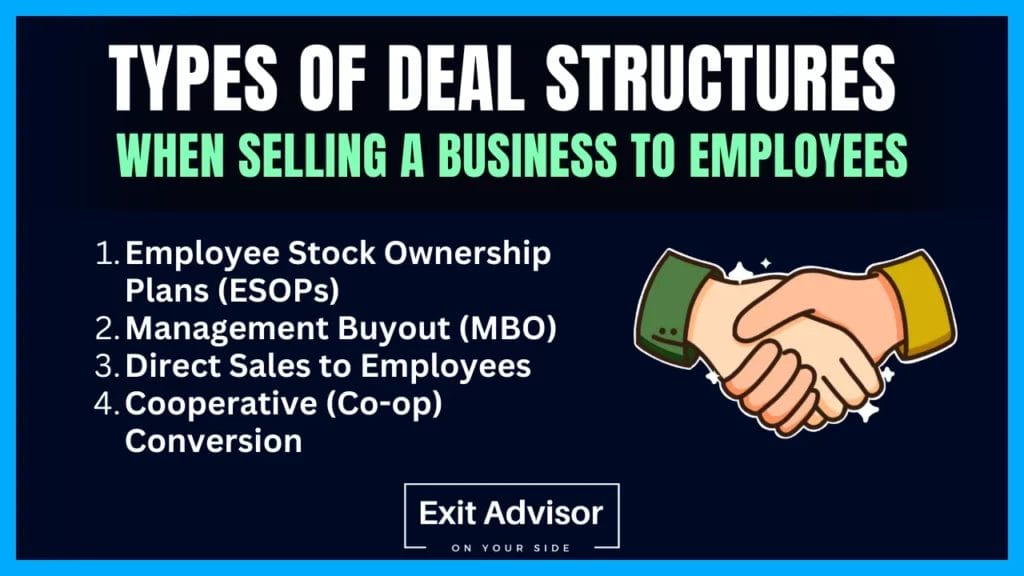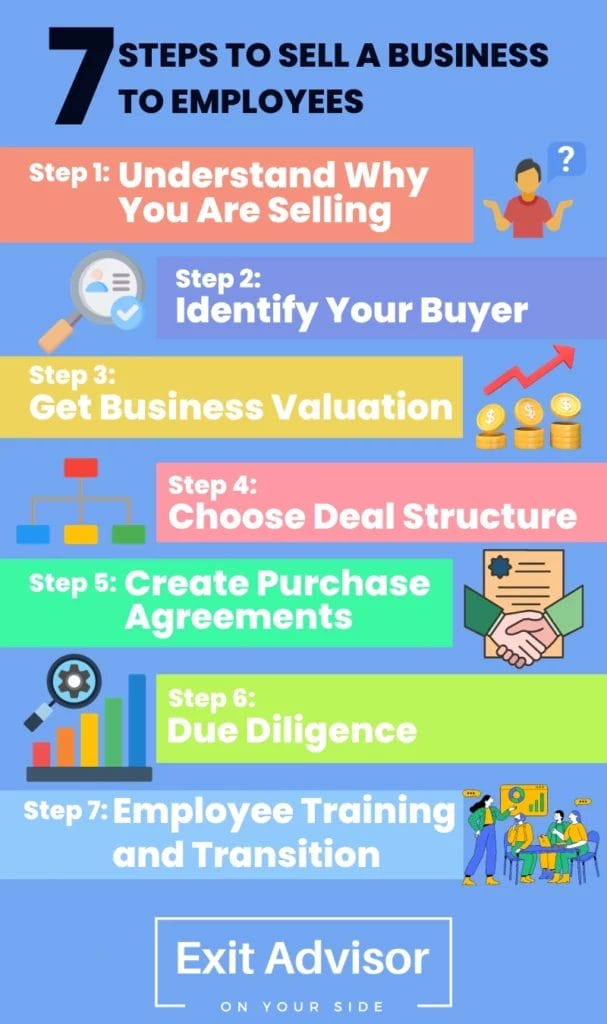When transitioning from business owner to retiree, selling your business to your employees may not be the first option that comes to mind. However, it can be a rewarding and fulfilling choice that can ensure the continuation of your legacy while providing your loyal employees with an exceptional opportunity.
In this article, we'll demystify selling your business to those who know it best – your employees. I'll walk you through everything you need to consider – from the preliminary stages to the final handover, making the process as smooth and understandable as possible.
So, whether you're nearing retirement or simply considering a career change, keep reading to understand how to successfully transition your business into the hands of your trusted staff.
Why Sell a Business to Employees?
Selling a business to employees can offer numerous benefits for both parties involved. For the owner, it provides an opportunity to retire with peace of mind, knowing their hard work and dedication will continue through their employees. It also allows them to receive a higher sale price than selling to an outside buyer and potential tax advantages.
For employees, it presents a unique opportunity to become business owners and take control of their future. It also ensures job security and a sense of ownership in the company they have helped build.
Additionally, selling to employees can create a positive culture within the workplace, as everyone is working towards a common goal and has a vested interest in the business's success.
Pros and Cons of Selling a Business to Employees

Pros of Selling a Business to Employees
- Continuity of Business: Selling to employees familiar with the company's operations and culture can ensure a smooth transition and continuity of business.
- Incentive for Employees: With ownership, employees gain a stronger sense of responsibility, leading to increased motivation and productivity.
- Potential for Higher Sale Price: Employees may be willing to pay a premium for a business they are already invested in and understand well, potentially resulting in a higher sale price.
- Tax Benefits: Depending on the sale structure, there can be attractive tax benefits when selling to employees.
- Employee Retention: The prospect of ownership can significantly boost employee retention. With a stake in the business, employees are likelier to stay with the company, reducing the costs and disruption of high turnover.
- Preserving Company Culture: Selling to employees can help preserve the company culture you have cultivated over the years. They already understand and appreciate the values and ethos of the company, thereby safeguarding its identity and reputation in the industry.
Cons of Selling a Business to Employees
- Financial Risk for Employees: Employees taking over a business may face financial risks if the business doesn't perform as expected.
- Financing Challenges: Employees may need help securing financing for the purchase, which can complicate the sale process.
- Potential Conflict: If only some employees are offered the opportunity to buy, it could create conflict within the team.
- Longer Transition: The transition period can be longer as employees learn to manage all business aspects.
Types of Deal Structures When Selling a Business to Employees

When selling your business to your employees, it's important to consider the various deal structures that can be employed. The choice of structure depends on various factors, such as the size of your business, the financial capacity of your employees, and the transfer timeline. Here are four common deal structures you might consider:
- Employee Stock Ownership Plans (ESOPs): An ESOP is a retirement plan allowing employees to own company stock. Under this structure, the company sets up a trust fund to contribute new shares or cash to buy existing shares. This option can be attractive because it allows the business owner to sell gradually over time and offers significant tax advantages. However, setting up an ESOP can be complex and costly, requiring a commitment to employee ownership.
- Management Buyout (MBO): In a leveraged management buyout, the existing management team rallies resources to acquire the business. This can be a good option if your management team is experienced and capable of running the business. Financing is often secured through a combination of seller financing, outside financing, and the personal resources of the management team.
- Direct Sales to Employees: This involves selling your business directly to one or more employees. The price and terms of the sale are negotiated between you and the buying employees. This option can be simpler and less expensive, but it requires the employee(s) to have sufficient financial resources.
- Cooperative (Co-op) Conversion: The business is sold to an employee-owned cooperative under this structure. This can be a good option for smaller businesses, and it fosters a democratic management style, as each member gets a vote in business decisions. However, it requires a cooperative spirit among employees and may need to be more suitable for larger businesses.
Each structure has pros and cons; the best choice depends on your circumstances. It's important to get legal and financial advice to understand the implications of each option. Once you've chosen a structure, you'll need to work with your advisor to navigate the sale process, which can include valuing the business, negotiating terms, and managing the transfer of ownership.
What is an Employee Stock Ownership Plan (ESOP)?
An Employee Stock Ownership Plan (ESOP) is a qualified retirement plan that provides employees with an ownership interest in the company by enabling them to hold its stock. ESOPs serve as an effective means for selling a business to employees and have several advantages from the perspective of both the owner and the employees.
It's a flexible option for business owners, allowing them to retain control until they are ready to retire fully, as they can gradually sell their share to the ESOP. This slow transition can provide peace of mind, ensuring their built business thrives.
Moreover, ESOPs can offer numerous tax benefits. For instance, in certain situations, sellers can defer or even avoid capital gains tax, enhancing the financial attractiveness of this option.
From the employees' perspective, ESOPs can empower them as they become partial company owners. This sense of ownership can yield a more committed and productive workforce, as they are working towards the success of a business with a financial stake. Moreover, as participants in the ESOP, they can receive significant retirement benefits, contributing to their long-term financial security.
However, setting up an ESOP can be complex and costly. It requires careful planning, legal expertise, and a substantial commitment to employee ownership. While it may not be the right fit for every business, it can be a powerful tool for business succession for companies with a culture of engagement and a committed workforce.
7 Steps to Sell a Business to Employees

Step 1: Understand Why You Are Selling
When selling your business to employees, it's crucial to understand your motivation behind the sale. This could be due to retirement, pursuing new ventures, or the desire to incentivize and retain your staff. To ensure a smooth transition, follow these steps:
- Clarify Objectives: Clearly define your goals and determine if selling to employees aligns with them. This will help you make informed decisions throughout the process.
- Communicate Openly: Maintain clear and transparent communication with your employees. Keep them informed about the sale process and address any concerns or questions they may have.
- Seek Professional Advice: Consult with legal and financial experts specializing in employee buyouts. They can guide you through the legal and financial aspects of the sale, ensuring a fair and successful transaction.
- Develop a Transition Plan: Create a detailed plan outlining the transition process. This includes determining the timeline, employee roles and responsibilities, and any necessary training or support.
- Offer Incentives: Consider offering incentives to employees interested in purchasing the business. This can motivate and encourage their involvement in the transition.
By following these steps, you can facilitate a successful sale of your business to your employees, ensuring a smooth transition and a positive outcome for all parties involved.
Step 2: Identify Your Buyer
Once you decide, it's time to identify potential buyers within your employee pool. Look for key members of your management team who have shown commitment and competence.
Consider long-term employees who have demonstrated loyalty and skill. Considering an Employee Stock Ownership Plan (ESOP) or a cooperative structure, you should include all employees as potential buyers.
By involving your employees in the buying process, you can foster a sense of ownership and empowerment within your organization. This can lead to increased motivation, loyalty, and productivity. Additionally, it allows you to reward and retain top talent while ensuring a smooth ownership transition.
Remember to communicate your intentions clearly and transparently to your employees. Provide them with the necessary information about the process, timeline, and expectations. Encourage open dialogue and address any concerns they may have. This will help build trust and ensure a successful transition for your employees and business. With better communication, you can even sell your failing business to anyone.
Step 3: Get Business Valuation
A formal business valuation is crucial to determine your business's fair and objective selling price. It should be conducted by a qualified appraiser who will carefully evaluate various factors. These factors include your business's financial performance, assets, market conditions, and the industry in which you operate.
By considering these elements, the appraiser can accurately assess your business's value. This valuation is essential to ensure you receive a proper and justifiable price when selling your business. Therefore, it is highly recommended to seek the expertise of a qualified appraiser to conduct a thorough evaluation. If you don’t have experience, contact The Exit Advisors; if you have some experience in business valuation, you can sell your business without a broker.
Step 4: Choose Deal Structure
As discussed earlier in this guide, there are several ways to structure the sale of your business to employees. You can choose private equity, direct cash payment, installment method, any third-party involvement, or direct deal for a successful exit strategy.
The right choice will depend on factors such as the size of your business, the financial resources of your employees, and the transfer timeline. It's crucial to engage legal and financial advisors to understand the implications of each option.
Step 5: Create Purchase Agreements
Once you have chosen a deal structure, the next step is to create a purchase agreement. This document is a crucial legal record that outlines the terms and conditions of the sale. It includes important details such as the purchase price, payment terms, and contingencies.
To ensure accuracy and legal compliance, it is highly recommended to collaborate with an experienced business attorney who can assist in drafting this document. Their expertise will help you avoid pitfalls and ensure the agreement is well-crafted and tailored to your needs.
By working closely with a knowledgeable attorney, you can have confidence in the integrity of the purchase agreement and protect your interests throughout the transaction process. Remember, creating a comprehensive and well-drafted purchase agreement is an essential step to safeguard the success of your business deal.
Step 6: Due Diligence
During the due diligence process, the buyer will carefully review your information about the business to ensure its accuracy. This typically includes examining financial records, contracts, and other relevant documents. Additionally, the buyer may want to interview key staff members and customers. It's crucial to maintain openness and transparency throughout this process.
Being cooperative and forthcoming can facilitate a smooth and successful due diligence experience.
The goal is to verify the business's information and build trust with the buyer. Stay organized, provide requested documents promptly, and address any concerns promptly to demonstrate your commitment to a mutually beneficial transaction.
Step 7: Employee Training and Transition
To ensure a successful transition of employees into their new roles as owners, it is crucial to prioritize training and support throughout the process. Here are some key steps to follow:
- Careful Planning: Start by developing a comprehensive plan that outlines the training objectives and timelines. Identify the skills and knowledge employees need to excel in their new roles.
- Detailed Operational Manuals: Provide employees with detailed operational manuals outlining their responsibilities, procedures, and best practices. These manuals should be a reference guide to help employees navigate their new roles effectively.
- Training Sessions: Conduct interactive training sessions to reinforce the information provided in the manuals. Use a combination of presentations, hands-on exercises, and role-playing scenarios to engage employees and ensure their understanding.
- Ongoing Support: Offer continuous support to employees as they transition into their new roles. Be available to answer questions, provide guidance, and address any challenges they may encounter. Encourage open communication to foster a supportive and collaborative environment.
Following these steps can facilitate a smooth and successful transition for employees, setting them up for long-term success as owners.
Step 8: Finalize Sale
To finalize the sale and transfer ownership to your employees, follow these simple steps:
- Sign the purchase agreement: Ensure all parties involved agree on the terms and conditions of the sale.
- Make required payments: Fulfill any financial obligations outlined in the agreement.
- File necessary documents: Submit all required paperwork to the relevant government agencies.
Once these steps are completed, congratulations! Your employees are now the proud new owners of the business.
Remember, selling your business to your employees can be a rewarding experience, but it requires careful planning and execution. Be sure to engage with experienced advisors who can guide you.
Things You Must Know Before Selling a Business to Employees
Leave the Business Gradually
Opting to transition out of your business gradually can significantly reduce the overall disruption caused by the change in ownership. This slow phase-out approach allows for a smoother transfer of knowledge and responsibilities, ensuring business continuity and reassuring employees and customers.
Employee Retention
Selling your business to your employees can serve as an effective retention strategy. It gives staff members a sense of ownership and vested interest in the company's future success, which may lead to increased job satisfaction and decreased turnover.
Employee Motivation
Employee ownership can greatly boost employee motivation and productivity. When employees are part-owners, they are more likely to be invested in their work, understanding that their efforts directly impact the business's success.
Tax Benefits
There are potential tax benefits associated with selling your business to your employees. For instance, in certain jurisdictions, owners who sell their businesses to an Employee Stock Ownership Plan (ESOP) may defer or potentially avoid capital gains tax.
Seller’s Legacy
Choosing to sell your business to your employees can help preserve the legacy you've built. Your staff, who have been a part of your company's journey, will likely maintain your business's core values and culture, carrying forward your vision into the future.
Know This Traditional Way to Sell a Small Business to Key Employees
The traditional business selling method to an employee involves a straightforward buyout. Often, this process commences when the owner identifies a capable and interested employee or group of employees who have the potential to steer the company competently.
In most cases, the purchase is financed by a commercial loan, and the payment terms are stretched over an agreed period, allowing the employees to pay off the debt using the company's profits.
According to a report by the National Center for Employee Ownership (NCEO), as of 2018, there are about 6,500 Employee Stock Ownership Plans (ESOPs) in the U.S., covering 14 million employees. This indicates the popularity and viability of the traditional employee buyout mechanism.
However, as straightforward as it seems, this method requires comprehensive due diligence, concrete financial planning, and adjustments to the business structure.
The transfer of ownership should be carefully orchestrated to ensure the business continues to operate smoothly during and after the transition. Legal and financial advisors should be involved to assist with the complexities involved.
Conclusion
Selling your business to your key employee can be a fulfilling and rewarding experience for both parties. As the owner, you can preserve your legacy while enabling your employees to advance in their careers and become part-owners of a thriving business.
However, it's essential to approach this process with careful planning and professional guidance to ensure a successful outcome for all parties involved. With these steps and considerations in mind, you can confidently sell your business to your dedicated employees.
So, always prioritize open communication, thorough planning, and ongoing support throughout the transition process for a smooth and successful transfer of ownership.










